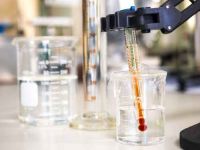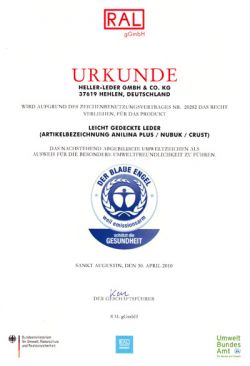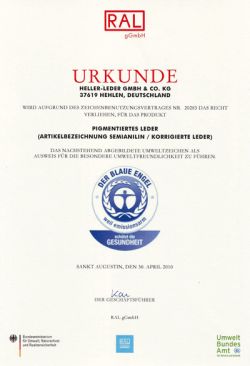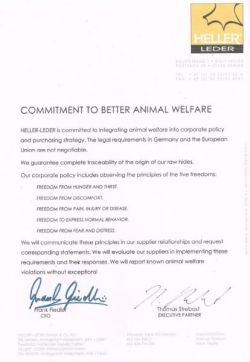Monitored, tested and certified. This is all based upon an in-house test lab, committed and highly qualified employees, and our understanding of quality assurance for all production and testing processes.
Wheth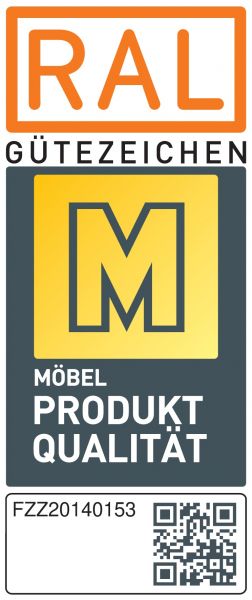 er BSE, Nitrofen or foot-and-mouth disease - recent scandals such as these have lent emphasis to the call for product labelling and consumer protection. However, at best, the labelling of a product serves as a pacifier. Reliable safety can only be guaranteed if requirements are not unrealistic, and meet people's needs. The DGM's comprehensive quality concept, with its quality assurance and certification regulations and comprehensive testing procedures, take these aspects into account. What about the Quality Mark as such, though, how is that protected?
er BSE, Nitrofen or foot-and-mouth disease - recent scandals such as these have lent emphasis to the call for product labelling and consumer protection. However, at best, the labelling of a product serves as a pacifier. Reliable safety can only be guaranteed if requirements are not unrealistic, and meet people's needs. The DGM's comprehensive quality concept, with its quality assurance and certification regulations and comprehensive testing procedures, take these aspects into account. What about the Quality Mark as such, though, how is that protected?
To guard against misappropriation of the 'Golden M', the Deutsche Gütegemeinschaft has incorporated a few simple but effective safety measures. Fundamentally, the following always applies:
- The quality assurance and certification of furniture is deposited and monitored at the administrative office of the Deutsche Gütegemeinschaft Möbel. Verification of the quality assurance "Golden M" is documented in the so-called certification license.
- Traders are permitted to advertise the fact that they supply furniture which has been awarded the Quality Mark. However, both advertising materials and showroom display may feature the Quality Mark only in connection with the products that have actually been awarded the mark.
So this quality mark does not only proofs the bought quality but outstanding service for the customer. Openness and transparency is obligatory for both, towards the certification as well as the products.
EMAS sets the highest standards for operational and systematic environmental protection and stands for the European Community Eco-Management and Audit Scheme Regulation No. 1221/2009. Established since 2001, the EMAS-LOGO is the award for the fact that a company or organization meets the demanding requirements of the European EMAS Regulation and that this has been confirmed by an independent environmental verifier.
The EMAS logo is the visible sign of:
- the introduction and audited implementation of an environmental management system in accordance with the EMAS Regulation,
- compliance with all relevant environmental legislation
- the credibility of audited environmental reporting,
- the active involvement of employees in environmental protection,
- the provision of information on the company's own environmental performance,
- offering an open dialogue with the public and all interested parties, and
- a commitment to regularly evaluate and continuously improve its own environmental performance.
This certificate is the approval of passing an extensive environmental audit by the BLC (British Leather Technology Center).
The audit is focusing mainly on chemical and environmental impacts of the leather production processes. These are measured, evaluated and verified. The impact of these processes on employees is also considered.
GOLD is the highest achievable status and HELLER-LEDER was the first tannery in Europe to receive this award.
This certification allows a worldwide comparison.
Further information can be found at: www.blcleathertech.com
Since 1978 the Blue-Angel is a quality mark for products and services which are rated as outstandingly environmental friendly.
In cooperation with the Federal Environment Agency HELLER-LEDER has defined the criteria for the evaluation of the product “furniture leather” and consequently received the new Blue-Angel eco-label as the first company worldwide.
ECO₂L Energy Controlled Leather -> The world’s first label for energy efficiency and CO₂ emissions of tanneries
The climate change is one of the central worldwide challenges of todays society. To reduce the risks of the global warming for human kind and nature, the average temperature increase must be limited considerably worldwide until the end of this century.
The German Leather Federation felt obliged to this commitment as well and presents with the ECO₂L label (energy controlled leather) the world’s first calculation and auditing model for determining the energy efficiency and the CO₂-emission of a tannery. ECO₂L was developed by the Forschungsgemeinschaft Leder (Leather Research Foundation) as an active contribution of a responsible leather industry towards climate protection and as a significant aspect to evaluate a sustainable leather production.
The ECO₂L certificate is assigned by the independant Forschungsinstitut für Leder- und Kunststoffbahnen gGmbH (FILK). Auditing is conducted on behalf of FILK by independent, officially appointed auditors.
OEKO-TEX® LEATHER STANDARD
OEKO-TEX® LEATHER STANDARD is an internationally standardised testing and certification system for leather and leather goods at all production levels, including accessory materials. The certification supports companies along the supply chain with the implementation of high human-ecological product safety. The certification serves as legally binding verification of successful product certification in all business processes in accordance with LEATHER STANDARD.
The LEATHER STANDARD label indicates that the labelled article has successfully passed a test for chemicals that are harmful to health. The basis for this test, which is carried out by an independent OEKO-TEX® partner institute, is the OEKO-TEX® criteria catalogue with several hundred regulated individual substances. The strict limit values and test criteria of the criteria catalogue are much stricter than the valid national and international specifications and include various parameters for safeguarding health. OEKO-TEX® updates the test criteria at least once per year and, in doing so, takes into account the latest scientific findings and changes to legislation.
TISAX (Trusted Information Security Assessment Exchange) was created as a system for exchanging standardized test results in the automotive industry that is optimized for supplier risk assessment.
TISAX is a test and exchange mechanism for test results based on the industry-specific standard VDA-ISA, which was developed with a view to conducting Information Security Assessments (ISA) in the ENX Association and is released and published by the Association of the Automotive Industry (VDA). The standard concerns the secure processing of information from business partners, the protection of prototypes and data protection in accordance with the General Data Protection Regulation (GDPR) for potential business between car manufacturers and their service providers or suppliers.





